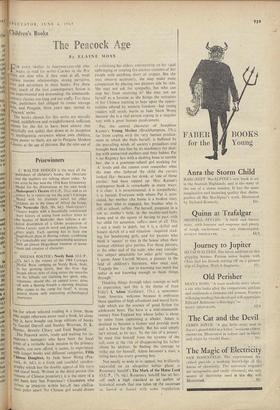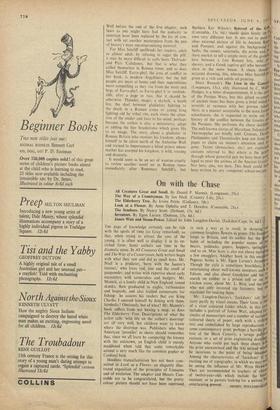ildren's Books
The Peacock Age
By ELAINE MOSS
Fon every twelve- to fourteen-year-old who .ants to read (or write) Catcher in the Rye `there are nine who, if they read at all, want Mature human relationships, strong narrative, imi'e and adventure in their books. For these nine, much of the best contemporary fiction is t00 experimental and demanding; the nineteenth- Century classics too long and too stuffy. For these nine, publishers feel obliged to create teenage lists, and Penguin, three years ago, started its Peacock' series.
The books chosen for this series are morally `ound, middlebrow and straightforward, sufficient reason for the list to have been almost (but mercifully not quite) shot down at its inception hY intelligentsia reviewers whose own children, more power to them, are up to Penguin Modern ( lassies at the age of thirteen. But the nine out of ten for whom selected reading is a boon, those Who might otherwise never read a book, let alone buy it, have bought out large editions of books FY Gerald Durrell and Stanley Weyman, D. K. uroster, Beverly Cleary and Enid Bagnold. .The Peacock series, ready and waiting for to- Morrow's teenagers who have been the focal point of a veritable book mission in the primary schools, can now afford, it seems, to experiment with longer books and different categories. Fifth (Ilinese Daughter, by Jade Snow Wong (Pea- cock, 4s. 6d.), is a fresh and youthful autobio- i>raPhy which has the double appeal of life story dnd travel book. Written in the third person (for reasons of Chinese propriety), it is the story of a girl born into San Francisco's Chinatown who s.trIves to integrate within heN.:If two civilisa- lions poles apart. No Chinese girl would dream of criticising her elders, commenting on her rigid upbringing or treating the ancient customs of her people with anything. short of respect. But she may observe accurately, she may make mute. comparison by placing two pictures side by side. She may not ask for sympathy, but who can stop her from receiving it? She may not see herself as a heroine as she brings the restraints of. her Chinese training to bear upon the oppor- tunities offered by western freedom—but young readers will surely warm to Jade Snow Wong because she is a real person coping in a singular way with a great human predicament: ' Pat, the central character of Josephine Kamm's Young Mother (Brockhampton, I5s.), far from coping wiih the very human predica- ment in which she finds herself, is buffeted by the prevailing winds of society's prejudices and brought back into line by its machinery for deal- ing with unmarried mothers and their babies. Pat is no Regency lass with a dashing beau to tumble her; she is a grammar-school girl working for 'A' levels and she cannot. even remember what the man who fathered the child she carries looked like—because her drink, at 'one of those parties,' had been topped up. Mrs. Kamm's courageous book ,is remarkable in many ways: it is clear: it is unsentimental; it is sympathetic; it is factual. Everyone with whom Pat is asso-' ciated, her mother (the home is a broken one), her sister who . is engaged, her brother who is still at school, suffers. Pat herself, pregnant in a job as mother's help, in the mother-and-baby home and in the agony of }laving to part with her child for adoption, suffers most of all. This, is not a study in depth, but it is a skilful and honest sketch. of a sad situation-- -required read- ing for headstrong girls, and for parents who think it 'square' to stay in the house when their teenage children give parties. For those parents, at the other end of the scale, who may consider this subject unsuitable for older girls' reading, 1 quote. Anne Carroll .Moore, a pioneer in the field of children's literature, who once said, 'Tragedy lies . . . not in knowing too much but rather in not knowing enough to think things through.' • Thinking things through takes courage as well as experience, and this is the. theme of Jean Fritz's I,. Adam.(Gollancz, 1 s.), a newcomer from America, welcome because it embraces those qualities of high adventure and moral forti- tude which. are the essence of good fiction for adolescent boys. The hero is a mid-nineteenth- century New England boy whose father is about to retire from captaining a whaler. Adam is destined to become a farmer and provide work and a home for the family. But his soul simply isn't stirred, as he says, 'by the size of a potato';
he must free himself from the tyranny of the soil, even at the risk of disappointing his father whom he idolises. In finding the courage to strike out for himself, Adam becomes a man, a fitting hero for every growing boy.
Not nearly so wide in its appeal, but brilliantly successful on an altogether loftier plane, is
Rosemary Sutcliff's The Mark of the Horse Lord (O.U.P., 17s. 6d.). Rosemary Sutcliff has set her- self such a high standard as an author of historical novels that one takes up the successor to Sward at Sunset with some trepidation.
Well before the end of the first chapter, such fears as one might have had the audacity to entertain have been replaced by the joy of con- tact with yet another masterpiece from the pen of history's most uncompromising minstrel.
For Miss Sutcliff spellbinds her readers, adult or almost adult, by refusing to sugar the pill: it may be more difficult to calls. Scots Dalriads' and Picts 'Caledones,' but that is what they called themselves in Roman times, and so does Miss Sutcliff. Earra-ghyl, the area of conflict in her book, is modern Argyllshire, but the hill people are more at home and their superstitions more compelling as they rise from the mists and bogs of Earra-ghyl, so Earra-ghyl it is; unthink- able, after a page or two, that it. should be otherwise. Thunder, magic, a skylark, a heath fire, the duel between gladiators fighting to the death in a Roman arena or young king fighting old by tribal rite, each rivets the atten- tion of the reader and lives in his mind, perhaps because the author is also a miniaturist, adept at adding the fine brushstroke which gives life to an image. The story, about a gladiator in Roman Britain who receives his freedom, allows himself to be taken north of the Antonine Wall and trained to impersonate%a blind prince whose mother has usurped his kingdom, is wild, rousing and dramatic.
It would seem to be an act of wanton cruelty to review another novel set in Roman times immediately after Rosemary Sutcliff's. but
Barbara Ker Wilson's Beloved of the Co! (Constable, 13s. 6d.) stands quite firmly on is own very different feet. It sets out to paint I clear external picture of life in Ancient Ref and Pompeii. and against the background °I baths, the senate, saturnalia, the arena and the slave market to tell a simple story of the gt ovi°g love between a free Roman boy, sold int° slavery, and a Greek captive girl who becomes° slave in the same house. A clean, detaantl' accurate drawing, this, whereas Miss Sutcliff given us a rich and subtle oil painting. Mary Renault's The Lion in the Gatet;11 (Longmans, 15s.), ably illustrated by C. WO° Hodges, is a bitter disappointment. It is the sten' of the Persian Wars, but this gifted re-creaSS. of ancient times has been given a brief whicb severely at variance with her proven talentsi Here, in a manner acceptable to the most forrna schoolroom, she is requested to write out She history of the conflict between the Greeks 0°' the Persians. She performs the chore dutifullY; The well-known stories of Marathon, Salamis and Thermopylae are briefly told; Croesus, Darius, Phidippides and Themistocles leap out from the pages to claim an instant's attention and are gone. Terms (democracy. etc.) arc explained' customs referred to. But where is the gen!Ys through whose powerful pen we have been pris'; leged to enter the animus of the Ancient Greeks' Not here, alas, not here. This book could Nile been written by any competent school-ma'an1.



































 Previous page
Previous page